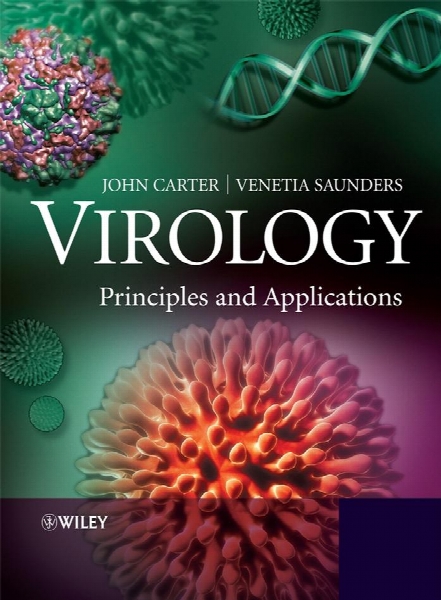Virology : principles and applications
- نوع فایل : کتاب
- زبان : انگلیسی
- مؤلف : John Carter; Venetia A Saunders
- ناشر : Chichester [u.a.] : Wiley
- چاپ و سال / کشور: 2007
- شابک / ISBN : 9780470023860
Description
Preface. Abbreviations used in this book. Greek letters used in this book. Colour coding for molecules. 1 Viruses and their importance. 1.1 Viruses are ubiquitous on Earth. 1.2 Reasons for studying viruses. 1.3 The nature of viruses. 1.4 The remainder of the book. 2 Methods used in virology. 2.1 Introduction to methods used in virology. 2.2 Cultivation of viruses. 2.3 Isolation of viruses. 2.4 Centrifugation. 2.5 Structural investigations of cells and virions. 2.6 Electrophoretic techniques. 2.7 Detection of viruses and virus components. 2.8 Infectivity assays. 2.9 Virus genetics. 3 Virus structure. 3.1 Introduction to virus structure. 3.2 Virus genomes. 3.3 Virus proteins. 3.4 Capsids. 3.5 Virion membranes. 3.6 Occlusion bodies. 3.7 Other virion components. 4 Virus transmission. 4.1 Introduction to virus transmission. 4.2 Transmission of plant viruses. 4.3 Transmission of vertebrate viruses. 4.4 Transmission of invertebrate viruses. 4.5 Permissive cells. 5 Attachment and entry of viruses into cells. 5.1 Overview of virus replication. 5.2 Animal viruses. 5.3 Bacteriophages. 6 Transcription, translation and transport. 6.1 Introduction to transcription, translation and transport. 6.2 Transcription of virus genomes. 6.3 Transcription in eukaryotes. 6.4 Translation in eukaryotes. 6.5 Transport in eukaryotic cells. 6.6 Transcription and translation in bacteria. 7 Virus genome replication. 7.1 Overview of virus genome replication. 7.2 Locations of virus genome replication in eukaryotic cells. 7.3 Initiation of genome replication. 7.4 Polymerases. 7.5 DNA replication. 7.6 Double-stranded RNA replication. 7.7 Single-stranded RNA replication. 7.8 Reverse transcription. 8 Assembly and exit of virions from cells. 8.1 Introduction to assembly and exit of virions from cells. 8.2 Nucleocapsid assembly. 8.3 Formation of virion membranes. 8.4 Virion exit from the infected cell. 9 Outcomes of infection for the host. 9.1 Introduction to outcomes of infection for the host. 9.2 Factors affecting outcomes of infection. 9.3 Non-productive infections. 9.4 Productive infections. 10 Classification and nomenclature of viruses. 10.1 History of virus classification and nomenclature. 10.2 Modern virus classification and nomenclature. 10.3 Baltimore classification of viruses. 11 Herpesviruses (and other dsDNA viruses). 11.1 Introduction to herpesviruses. 11.2 The human herpesviruses. 11.3 The herpesvirus virion. 11.4 HSV-1 genome organization. 11.5 HSV-1 replication. 11.6 Latent herpesvirus infection. 11.7 Other dsDNA viruses. 12 Parvoviruses (and other ssDNA viruses). 12.1 Introduction to parvoviruses. 12.2 Examples of parvoviruses. 12.3 Parvovirus virion. 12.4 Parvovirus replication. 12.5 Other ssDNA viruses. 13 Reoviruses (and other dsRNA viruses). 13.1 Introduction to reoviruses. 13.2 Rotavirus virion. 13.3 Rotavirus replication. 13.4 Other dsRNA viruses. 14 Picornaviruses (and other plus-strand RNA viruses). 14.1 Introduction to picornaviruses. 14.2 Some important picornaviruses. 14.3 The picornavirus virion. 14.4 Picornavirus replication. 14.5 Picornavirus recombination. 14.6 Picornavirus experimental systems 14.7 Other plus-strand RNA viruses. 15 Rhabdoviruses (and other minus-strand RNA viruses). 15.1 Introduction to rhabdoviruses. 15.2 Some important rhabdoviruses. 15.3 The rhabdovirus virion and genome organization. 15.4 Rhabdovirus replication. 15.5 Other minus-strand RNA viruses. 15.6 Viruses with ambisense genomes. 15.7 Reverse genetics. 16 Retroviruses. 16.1 Introduction to retroviruses. 16.2 Retrovirus virion. 16.3 Retrovirus replication. 16.4 Examples of retroviruses. 16.5 Retroviruses as gene vectors. 16.6 Endogenous retroviruses. 17 Human immunodeficiency viruses. 17.1 Introduction to HIV. 17.2 HIV virion. 17.3 HIV genome. 17.4 HIV-1 replication. 17.5 HIV-1 variability. 17.6 Progression of HIV infection. 17.7 Prevention of HIV transmission. 18 Hepadnaviruses (and other reverse-transcribing DNA viruses). 18.1 Introduction to hepadnaviruses. 18.2 Importance of HBV. 18.3 HBV virion. 18.4 Non-infectious particles. 18.5 Soluble virus protein. 18.6 HBV genome. 18.7 HBV genetic groups. 18.8 HBV replication cycle. 18.9 Prevention and treatment of HBV infection. 18.10 Other reverse-transcribing DNA viruses. 19 Bacterial viruses. 19.1 Introduction to bacterial viruses (bacteriophages. RNA PHAGES. 19.2 Single-stranded RNA phages. 19.3 Double-stranded RNA phages. DNA PHAGES. 19.4 Single-stranded DNA phages. 19.5 Double-stranded DNA phages. 20 Origins and evolution of viruses. 21.1 Introduction to origins and evolution of viruses. 20.2 Origins of viruses. 20.3 Evolution of viruses. 21 Emerging viruses. 21.1 Introduction to emerging viruses 21.2 Viruses in new host species 21.3 Viruses in new areas 21.4 Viruses in new host species and in new areas 21.5 New viruses 21.6 Recently discovered virus 21.7 Re-emerging viruses 21.8 Virus surveillance 21.9 Dealing with outbreaks 22 Viruses and cancer 22.1 Introduction to viruses and cancer 22.2 Papillomavirus-linked cancers 22.3 Polyomavirus-linked cancers 22.4 Epstein-Barr virus-linked cancers 22.5 Kaposi's sarcoma 22.6 Adult T cell leukaemia 22.7 Hepatocellular carcinoma 22.8 Virus-associated cancers in animals 22.9 Cell lines derived from virus-associated cancers. 22.10 How do viruses cause cancer? 22.11 Prevention of virus-induced cancers. 23 Survival of infectivity. 23.1 Preservation of virus infectivity. 23.2 Destruction of virus infectivity. 23.3 Inactivation targets in virions. 23.4 Inactivation kinetics. 23.5 Agents that inactivate virus infectivity. 24 Virus vaccines. 24.1 Introduction to virus vaccines. 24.2 Live attenuated virus vaccines. 24.3 Inactivated virus vaccines. 24.4 Virion subunit vaccines. 24.5 Live recombinant virus vaccines. 24.6 Mass production of viruses for vaccines. 24.7 Virus-like particles. 24.8 Synthetic peptide vaccines. 24.9 DNA vaccines. 24.10 Storage and transport of vaccines. 25 Anti-viral drugs. 25.1 Introduction to anti-viral drugs. 25.2 Development of anti-viral drugs. 25.3 Examples of anti-viral drugs. 25.4 Drug resistance. 25.5 Anti-viral drug research. 26 Prions. 26.1 Introduction to prions. 26.2 Transmissible spongiform encephalopathies. 26.3 The nature of prions. 26.4 Prion diseases. 26.5 Prion strains. 26.6 Prion transmission. 26.7 The protein-only hypothesis. Learning outcomes. Sources of further information. Virologists' vocabulary. Index.
Virology: Principles and Applications is a clear and accessible introduction to this fast-moving field, providing a comprehensive resource enabling the reader to understand the key concepts surrounding this exciting subject


